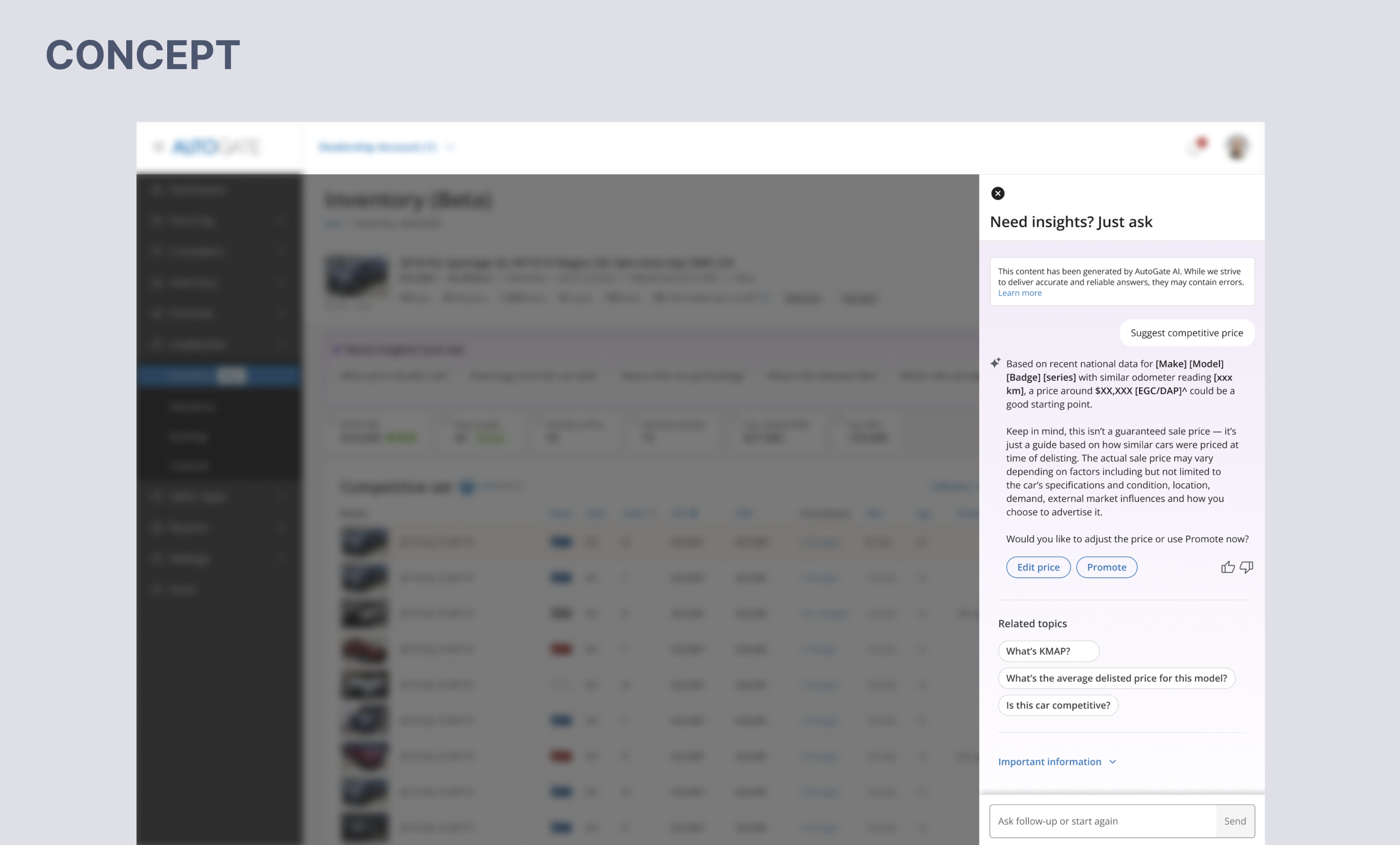
Summary
Context
Dealers rely on our subscription product to access data and insights about their inventory. While valuable, the experience is:
- data heavy and often overwhelming,
- requires prior knowledge or training to interpret.
With the rise of AI in digital platforms, leadership asked us to explore how AI could make this experience simpler. We identified a strong opportunity: using AI to present complex data in a more conversational, easy-to-grasp format.
However, our AI team was under-resourced, and timelines were tight. The challenge became:
👉 How might we ship a lightweight AI-powered feature that demonstrates value quickly, while setting the foundation for deeper functionality later?
My role and approach
As a lead designer on the project, I was responsible for shaping the AI insights experience — from defining the MVP to delivery as well as creating a long-term vision. I worked cross-functionally with product, engineering, and legal to ensure the feature was feasible, compliant, and user-friendly.
Impact

Process
Defining high-value questions
I partnered closely with our PM to identify which dealer questions would be most valuable at the stock-item level. We brainstormed around dealer jobs-to-be-done and mapped which data points could realistically support them.

Aligning with the AI team

Content and copy
Since the goal was to reduce cognitive load, the language for both prompts and responses needed to be clear, simple, and approachable — but also concise enough to fit naturally within the dealer workflow. For the first release, we limited the scope to just a handful of predefined prompts. This allowed us to avoid a lengthy evaluation phase, ship faster for the dealer conference, and still demonstrate the value of AI. Free-text input, where dealers could ask any question, was planned for later releases.

Legal alignment
Because the feature generated dealer-facing responses, there was a risk of misinterpretation or overpromising.
I worked closely with the legal team to review copy and ensure wording was accurate and compliant. This collaboration ensured we launched a feature that felt helpful without exposing the business to unnecessary risk.
Feasibility check
Given the tight timeline, I worked with engineers early to confirm the designs could be implemented quickly and without added complexity. This helped avoid last-minute compromises, kept scope realistic, and ensured we delivered in time for the dealer conference.
Design validation
With no time for formal user testing pre-launch, I leaned on best practices and consulted other designers for feedback on clarity and usability. Peer critique helped refine flows and copy, giving me confidence in the designs before handover.

Delivery
The MVP launched with a set of predefined prompts and conversational responses. While simple, this approach allowed us to put AI in front of dealers quickly, showcase innovation at the event, and gather real feedback.

Results and next steps
The MVP was delivered on time for the dealer conference, giving a concrete example of AI innovation in our platform. However, engagement with the predefined prompts was lower than expected. Post-launch analysis revealed two key reasons:
- Redundancy: dealers didn't see value in simplified rephrasing of data they already had access to.
- Effort: Clicking on prompts added friction — dealers preferred insights to be surfaced automatically in context.
Despite lower usage, the release was a valuable milestone. It validated that dealers are open to AI assistance, but also reframed how we thought about AI’s role — less about simplifying existing data, and more about delivering novel, actionable intelligence with minimal friction.
Where are we now?
We’re now in the process of iterating on the next versions to directly address the findings from the MVP.
That means reassessing the AI capability, and prioritising improvements. A key challenge is our dependency on the AI team, which is currently limiting the speed at which we can move. Still, we’re focusing our design and product work on:
- surfacing new insights, providing answers dealers can't easily derive themselves, such as why certain stock isn't selling;
- reducing interaction effort, shifting towards proactively surfaced insights, reducing clicks and making information insantly visible;
- building toward free-text queries, enabling dealers to ask their own questions.


What I learned
Navigating trade-offs
Shipping fast for the hard deadline meant making trade-offs. Instead of seeing that as limiting, I learned how to design lean MVPs that still demonstrate value and set the foundation for iteration.
Collaboration for impact
Partnering with the AI team, developers, and legal reminded me that good design is rarely just pixels. Copy, compliance, and feasibility are all part of delivering a real-world product — and my role is to bridge those gaps.




